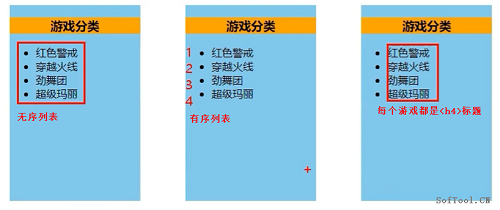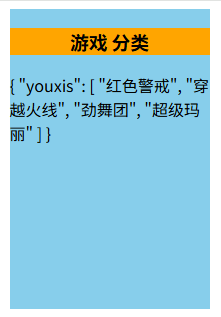笔记
本节想实现的效果:

数据放在 子组件 中,数据的结构是由 使用者(父组件) 来定。
本节讲的 作用域 的意思:
子组件Category.vue的使用者App.vue, 如何得到原本放在 子组件Category.vue里面的数据games[] 。
本节最终的效果:
- 数据在子组件Category.vue;
- 数据在子组件Category.vue生成的结构由使用者App.vue来决定;
先看看 使用者父组件 通过scop可以看到的效果
父组件使用插槽的源码:

{{softool}}的输出子组件传递过来的内容:

总结
插槽
作用
让父组件可以向子组件指定位置插入html结构,也是一种组件间通信的方式,适用于 父组件 ===> 子组件 。分类
默认插槽、具名插槽、作用域插槽使用方式:
3.1 默认插槽:
父组件中:
<Category>
<div>html结构1</div>
</Category>
子组件中:
<template>
<div>
<!-- 定义插槽 -->
<slot>插槽默认内容...</slot>
</div>
</template>3.2 具名插槽:
父组件中:
<Category>
<template slot="center">
<div>html结构1</div>
</template>
<template v-slot:footer>
<div>html结构2</div>
</template>
</Category>
子组件中:
<template>
<div>
<!-- 定义插槽 -->
<slot name="center">插槽默认内容...</slot>
<slot name="footer">插槽默认内容...</slot>
</div>
</template>3.3 作用域插槽:
理解:数据在组件的自身,但根据数据生成的结构需要组件的使用者来决定。(games数据在Category组件中,但使用数据所遍历出来的结构由App组件决定)
具体编码:
父组件中:
<Category>
<template scope="scopeData">
<!-- 生成的是ul列表 -->
<ul>
<li v-for="g in scopeData.games" :key="g">{{g}}</li>
</ul>
</template>
</Category>
<Category>
<template slot-scope="scopeData">
<!-- 生成的是h4标题 -->
<h4 v-for="g in scopeData.games" :key="g">{{g}}</h4>
</template>
</Category>
子组件中:
<template>
<div>
<slot :games="games"></slot>
</div>
</template>
<script>
export default {
name:'Category',
props:['title'],
//数据在子组件自身
data() {
return {
games:['红色警戒','穿越火线','劲舞团','超级玛丽']
}
},
}
</script>重要文件源码
App.vue
<template>
<div class="container">
<!--
<Category title="游戏">
<ul>
<li v-for="(g,index) in games" :key="index">{{ g }}</li>
</ul>
</Category>
<Category title="游戏">
<ul>
<li v-for="(g,index) in games" :key="index">{{ g }}</li>
</ul>
</Category>
<Category title="游戏">
<ul>
<li v-for="(g,index) in games" :key="index">{{ g }}</li>
</ul>
</Category>
-->
<!-- 因为我把数据放到了 子组件Category.vue ,所以继续简化 -->
<Category title="游戏">
<!-- 无序列表
如果想接收到 子组件 通过 插槽传递过来的 games,就需要在外面包裹一层 <template scope=""></template>
下面的意思: 把Category.vue子组件 slot插件提交过来的内容 给 softool ,然后在此使用的时候,从 softool 内拿数据即可。
-->
<template scope="softool">
<!--{{ softool }}-->
<ul>
<li v-for="(g,index) in softool.youxis" :key="index">{{ g }}</li>
</ul>
</template>
</Category>
<!-- 有序列表 -->
<Category title="游戏">
<template scope="softool">
<ol>
<li style="color:red" v-for="(g,index) in softool.youxis" :key="index">{{ g }}</li>
</ol>
</template>
</Category>
<Category title="游戏">
<!--<template scope="softool">
下面是第2种写法: //新旧API带来的现象
-->
<template slot-scope="softool">
<h4 v-for="(g,index) in softool.youxis" :key="index">{{ g }}</h4>
</template>
</Category>
</div>
</template>
<script>
//1. 引入组件
import Category from './components/Category.vue'
export default {
name:'App',
//2. 注册组件
components: { Category },
//上两节课 和 目前的使用场景: Category.vue子组件的使用者App.vue在哪,数据就在哪。
/*data() {
return {
games: ['红色警戒', '穿越火线', '劲舞团', '超级玛丽']
}
}*/
}
</script>
<style>
.container, .foot{
display: flex;
justify-content: space-around;
}
img{
width: 100%;
}
video{
width: 100%;
}
</style>components\Category.vue
<template>
<div class="category">
<h3>{{ title }} 分类</h3>
<!-- 本节: 因为把数据放在这里,那么我就在此处拿数据放这里
此处的意思: 把数据games 通过 youxis属性 传递给了 slot 的使用者。
即: 以 youxis 为 key, 以 games 为 value 提交给 当前插件Category.vue 的使用者(父组件)
-->
<slot :youxis="games">我是默认的一些内容</slot>
</div>
</template>
<script>
export default {
name:'CategoryVue',
props:['title'],
data() {
return {
games: ['红色警戒', '穿越火线', '劲舞团', '超级玛丽']
}
}
}
</script>
<style>
.category{
background-color: skyblue;
width: 200px;
height: 300px;
}
h3{
text-align: center;
background-color: orange;
}
/*
img{
width: 100%;
}
*/
</style>